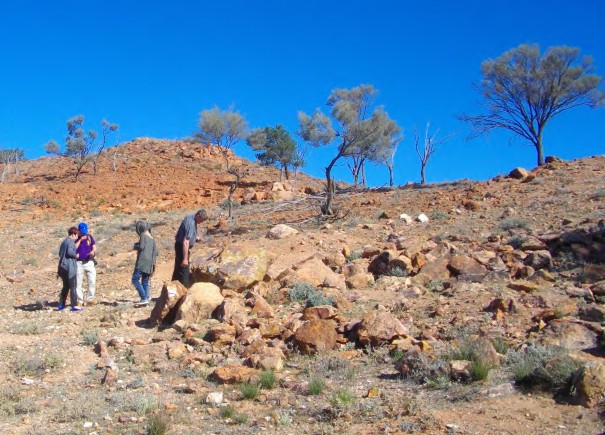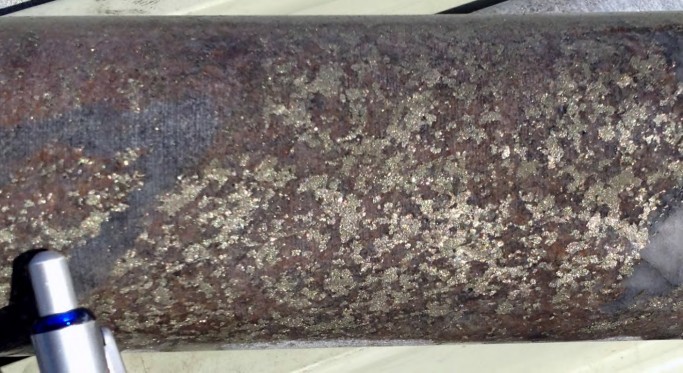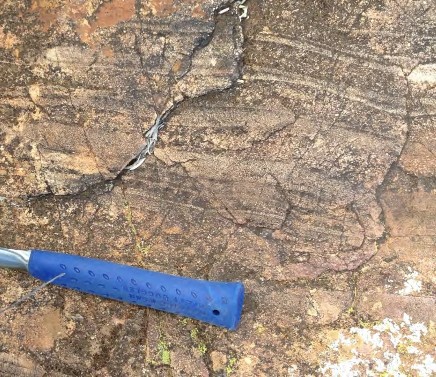
Author: Ian Pringle, Consultant Geologist, Ian J Pringle & Associates
Extract from National Rock Garden Newsletter No. 13, September 2016
The rock of the month is a plagioclase-quartz-pyrite gneiss unit of the Himalaya Formation, Thackaringa Group, located about 25km SW of Broken Hill In western NSW. The age of the rock unit is 1,699 ± 10 million years (Statherian Period, Paleoproterozoic Era). The rock is very unusual in that it is made up almost entirely of quartz, pyrite, and sodium-rich plagioclase feldspar (albite). It forms stratabound lenses, often several kilometres long and several tens of metres thick within the Thackaringa Group located stratigraphically below the Broken Hill Group which hosts the massive Broken Hill orebody.
The pyrite within the rock contains cobalt (typically 0.4% – 0.6% Co) and because of the physical extent of the stratabound pyrite horizons, they represent very large, low-grade cobalt deposits. The rock is a paragneiss, meaning that it was formed by high-grade metamorphism of sedimentary rocks, and its origin has been debated by many geologists. The author considers that it originated as sulphide-enriched biogenic sediments in a shallow anoxic and saline basin (Pringle 2015). In any event, cobalt-pyrite horizons of this type and extent are unique to the Broken Hill area.
A large rock specimen could be collected on the east side of the ridge near a small saddle on Pine Hill (also called Pyrite Hill) on Thackaringa Station. This location is within Exploration Licence 6622 held by
Broken Hill Prospecting Pty Ltd. The photograph in Figure 1 shows boulders dislodged during costeaning. Future work will require fresh costeans and a large specimen could be obtained to suit the requirements of the National Rock Garden.

The deposits have combined mineral resources of 35.7 million tons of cobalt-pyrite ore with an average grade of 1.85 pounds per ton of cobalt (66 million pounds (30,000 tons) of contained cobalt). In addition, between 37 and 59 million tons of additional pyrite mineralization of similar cobalt grade is estimated to contain between 63 and 101 million pounds of cobalt (29,000–45,000 tons). The deposits are likely to extend further at depth and also along trend, and this will need to be verified by further exploration. The deposits have negligible contents of gold, silver, copper, rare earth elements or deleterious metals such as arsenic, mercury, antimony or lead.
Cobalt is a major component in many new rechargeable lithium-ion batteries (electric vehicles, mobile phones, notebooks and laptop computers) and some contain up to 60% cobalt content. Cobalt has been used for centuries as a pigment for bright blue colouring and more recently in super alloys and high pressure-temperature resistant metals in turbines, jet motors, military hardware, aircraft and space equipment. It is also the principle component of vitamin B12, essential for blood and brain function. The Democratic Republic of Congo accounted for about 60% of global 2015 cobalt production (92,000 tons) and most of this was byproduct from copper mining.
Broken Hill Prospecting has completed scoping studies for the co-production of sulphuric acid and cobalt and these have highlighted significant potential for a long term project with low capital start-up and staged development. Australia imports about half a million tons of sulphuric acid (and sulphur) each year, and several excellent opportunities for supply of sulphuric acid into domestic fertilizer and mineral processing industries have been identified. Co-generated electric thermal power and hematite could also add considerable value.
The project has potential to provide long-term cobalt and sulphuric acid supply. For example, a mine processing 7.5 million tons of cobalt-pyrite ore per year could produce about 1.5 million tons of pyrite concentrate (averaging 0.45% cobalt) containing 6,750 tons of cobalt metal. Processing of the concentrate could also produce several million tons of sulphuric acid each year.


References
Pringle, I., 2015. The Rumen Model – A new mineral deposit type for cobalt mineralisation near Broken Hill and comments on the formation of other cobalt deposits. Presentation dated 14 May 2015. Available at http://www.smedg.org.au/Pringle_Mar12.html
Broken Hill Prospecting Pty. Ltd., 2016. Summary of the Pyrite Hill, Big Hill and Railway deposits. http://www.bhpl.biz/projects/cobalt-deposits/
Stevens, B. P. J., Page, R. W. and Crooks, A., 2008. Geochronology of Willyama Supergroup metavolcanics, metasediments and contemporaneous intrusions, Broken Hill, Australia. Australian Journal of Earth Sciences, 55:3, http://www.tandfonline.com/doi/pdf/10.1080/08120090701769456


